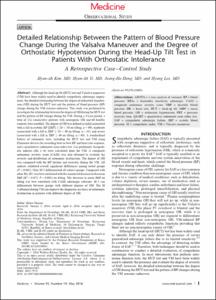Detailed relationship between the pattern of blood pressure change during the Valsalva maneuver and the degree of orthostatic hypotension during the head-up tilt test in patients with orthostatic intolerance: A retrospective case-control study
- Alternative Author(s)
- Kim, Hyun Ah; Yi, Hyon Ah; Hong, Jeong Ho; Lee, Hyung
- Journal Title
- Medicine
- ISSN
- 0025-7974
- Issued Date
- 2016
- Abstract
- Although the head-up tilt (HUT) test and Valsalva maneuver
(VM) have been widely used to identify sympathetic adrenergic impairment,
the detailed relationship between the degree of orthostatic hypotension
(OH) during the HUT test and the pattern of blood pressure (BP)
change during the VM remains unknown. This study was performed to
investigate the relationship between the degree ofOHduring theHUT test
and the pattern of BP change during the VM. During a 4-year period, a
total of 132 consecutive patients with neurogenic OH and 60 healthy
controls were enrolled. The degree ofOHwas defined asmild (associated
with a fall in systolic BP [SBP] 20 < 30 on tilting, n¼49), moderate
(associated with a fall in SBP 30 < 40 on tilting, n¼43), and severe
(associated with a fall in SBP 40 on tilting, n¼40). A standardized
battery of autonomic tests, including the HUT test and VM using
Finometer devices for recording beat-to-beat BP and heart rate response,
and a quantitative sudomotor axon reflex test, was performed. Sympathetic
indexes (SIs 1–6) were calculated from the VM. A composite
autonomic severity score (CASS) was also obtained to evaluate the
severity and distribution of autonomic dysfunction. The degree of OH
was compared with the BP decline and recovery during the VM. All
indexes exhibited overall significant differences among tested groups
(P<0.001). Only SI 3 differentiated all subject groups. Compared with
other SIs, SI 3 was best correlatedwith the amount of decrease in the mean
SBP (R2¼0.473, P<0.001) on tilting. The decrease in mean SBP on
tilting was best correlated with CASS adrenergic subscore. SI 3 can
differentiate between groups with different degrees of OH. The SI
3 obtained duringVMcan improve the diagnostic accuracy of autonomic
dysfunction in patients with different degree of OH.
- Publisher
- School of Medicine
- Citation
- Hyun-Ah Kim et al. (2016). Detailed relationship between the pattern of blood pressure change during the Valsalva maneuver and the degree of orthostatic hypotension during the head-up tilt test in patients with orthostatic intolerance: A retrospective case-control study. Medicine, 95(19), e3608–e3608. doi: 10.1097/MD.0000000000003608
- Type
- Article
- ISSN
- 0025-7974
- Appears in Collections:
- 3. Research Institutues (연구소) > Brain Research Institute (뇌연구소)
1. School of Medicine (의과대학) > Dept. of Neurology (신경과학)
- 파일 목록
-
-
Download
 oak-2016-0068.pdf
기타 데이터 / 4.67 MB / Adobe PDF
oak-2016-0068.pdf
기타 데이터 / 4.67 MB / Adobe PDF
-
Items in Repository are protected by copyright, with all rights reserved, unless otherwise indicated.